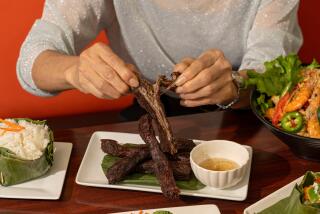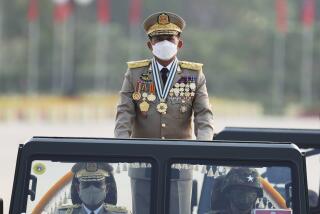Socialist System Ineffectual : Private Enterprise Thrives in Exotic Burma
- Share via
RANGOON, Burma — Behind the moldering facades of Imperial Britain, in the steamy alleys of this exotic Asian capital, a vigorous black market as well as legitimate enterprises have survived one of Asia’s most stifling economic systems.
Rangoon is often described as a languid backwater caught in a time warp, a city best symbolized by Burmese idly smoking cheroots by the river and a clock on the Customs House that stopped at 20 minutes to midnight--more than a decade ago.
But at the Rangoon Iron Bazaar, in the markets of Indiatown and in the inner city’s teeming byways, the click of the abacus from inside dusky shop houses signifies intense wheeling and dealing.
A customer orders a certain video player. The model is currently out of stock, but two weeks later it appears in its original packaging after being smuggled by sea, river and land from the Malaysian island of Penang.
An aging car finally expires. It’s stripped locust-like, and in short order the body becomes spoons and pans while the innards are extracted to stock a vast, spare parts market that literally keeps Burma running.
Only rotting rice available in government stores? No problem: The sidewalk economy is a cornucopia of dried shrimp, red chilies, sesame oil and high-quality rice.
Burma’s private enterprise should in theory have shriveled to insignificance because 25 years ago a general, Ne Win, overthrew a civilian government and instituted a system that attempts to blend Marxist economics, Buddhism and autocratic, military-dominated political rule. But rather than fade away, private enterprise has flourished, legally and illegally.
Despite the back-alley vigor, overall change has come slowly to Rangoon, as compared to Asia’s many booming capitals. The stagnant socialist system has in fact saved the city--a living museum of Victorian and Edwardian architecture--from the bulldozer that has already razed much of the past elsewhere in Asia.
Many residents in the inner area are crowded into once-elegant, now decaying, apartments from British colonial days. Rangoon’s tallest building--besides the towering Shwedagon Pagoda--is the eight-story Soviet Embassy. And unlike other urban centers on the continent, where many activities have been relegated behind closed doors, much of life is still played out in the open, village-style.
You can buy curried noodles, Rambo posters, a 1950 issue of Reader’s Digest and dried snake for medicinal purposes on Rangoon’s sidewalks. You can have your ears cleaned, palms read or marriage certificate typed by a battery of clerks pecking on 30-year-old typewriters. Families take baths, spank children, play games and chat with neighbors outside their front doors.
Some influences from the outside have penetrated this tapestry of old Asia in recent years. Traffic has thickened considerably, and the vintage cars that once plied quiet streets have been largely replaced by fleets of Japanese pickup trucks, which Burmese sailors are permitted to send in from abroad.
Consequently, a haze of bluish pollutants rises around the golden spires of the centuries-old Sule Pagoda at the city center, a foreshadowing of what will probably occur if Burma sheds its isolationism and the economy improves.
Western videotapes are a hot item in the smuggler’s sack.
Foreign movies are shown publicly although strict censorship, combined with meager funds to pay for high-quality imports, results in such third-rate fare as “Legend of Dinosaurs and Monster Birds” and “My Sweet Lahaine” with Ken Apache and Herb Edelman.
Latest Fads
Sarongs are still the standard attire for virtually everyone but policemen and soldiers. But men sometimes top them with Western T-shirts and, the latest fad, aviator glasses. Older Burmese complain of young women losing their modesty by favoring bodice-hugging, see-through blouses.
Rangoon has escaped some of the ills of its Westernizing, modernizing Asian sisters. Murders and rapes are few and nobody can recall a case of kidnaping. There have been no reports of the deadly acquired immune deficiency syndrome surfacing.
But the city is hardly free of problems. Rangoon has grown from a pre-World War II population of fewer than half a million to between 2.5 million and 3 million today, with only minimal improvements in infrastructure and social services.
Water Shortage
Open sewers run past many buildings and rats scurry out of garbage heaps. Water is in short supply because Rangoon relies on two prewar reservoirs and a third is seven years behind completion schedule. City streets look as if an earthquake had passed through.
Older Rangoon residents remember a stately, airy city known as the “Pearl of the Orient” and a postwar period when resource-rich Burma was widely regarded as the future economic powerhouse of Southeast Asia. And almost everyone grumbles about current conditions.
Dissatisfaction reached a new high after a recent withdrawal from circulation of about 60% of the local currency notes--with no compensation by the government.
More to Read
Sign up for Essential California
The most important California stories and recommendations in your inbox every morning.
You may occasionally receive promotional content from the Los Angeles Times.













